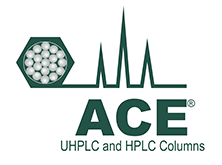Introduction
This application note presents a gradient method for the analysis of eight common ingredients found in energy drinks. The method was developed on an ACE 3 C18-Amide column using a VWR Hitachi Chromaster HPLC system. All eight components were readily separated on the ACE C18-Amide using a reversed-phase gradient (chromatogram A). The method was then applied to the analysis of two commercially available energy drinks (chromatograms B and C) and was proved to be suitable for detection of all eight analytes without interference from other sample peaks. Caffeine was found to be present in the largest quantity in both energy drinks. The standard amount of caffeine found in energy drinks is 80 – 150 mg per serving, with anything containing over 150 mg/L needing to be stated as having a “high caffeine content”, and being unsuitable for consumption by children and pregnant women. The two drinks analysed in this study contain approximately 30 mg and 12 mg of caffeine per 100 mL respectively. The average daily caffeine consumption for adults is recommended not to exceed 400 mg on a regular basis.

Both energy drinks analysed in this application also contained two of the most common artificial sweeteners; aspartame and acesulfame K. These sweeteners are approximately 200-times sweeter than natural sugars and are added to soft drinks to induce a sweet taste, without the associated energy content of natural sugars such as sucrose. Artificial sweeteners also do not increase blood sugar levels after consumption and so may be suitable for diabetics. Both aspartame and acesulfame K have been deemed safe for human consumption within the quantities used in energy drinks with no proven adverse effects discovered to date.





